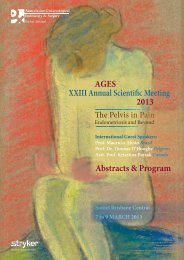to Obstetric Trauma Pelvic Floor Repair Surgical Essentials - AGES
to Obstetric Trauma Pelvic Floor Repair Surgical Essentials - AGES
to Obstetric Trauma Pelvic Floor Repair Surgical Essentials - AGES
Create successful ePaper yourself
Turn your PDF publications into a flip-book with our unique Google optimized e-Paper software.
<strong>AGES</strong><br />
<strong>Pelvic</strong> <strong>Floor</strong><br />
Symposium &<br />
Workshop XII<br />
2011<br />
<strong>to</strong><br />
<strong>Obstetric</strong> <strong>Trauma</strong><br />
<strong>Pelvic</strong> <strong>Floor</strong> <strong>Repair</strong><br />
<strong>Surgical</strong> <strong>Essentials</strong><br />
18<br />
review of the procedure-specific complications, demonstrating an<br />
increased incidence of bowel injuries <strong>to</strong> 2.2% compared with the<br />
previous rate of 0.5%.<br />
In addition <strong>to</strong> this, emerging techniques are also associated with<br />
a new, and sometimes unanticipated, spectrum of complications.<br />
Further discussion will be granted <strong>to</strong> novel complications arising,<br />
including an interesting case of pubic osteomyelitis following LSCP.<br />
REFERENCE:<br />
<strong>Surgical</strong> management of pelvic organ prolapse in women. Cochrane<br />
Database of Systematic Reviews. April 2010. C. Maher, B. Feiner, K.<br />
Baessler, M. Glazener<br />
AUTHOR AFFILIATION: G. Cario, D. Chou, D. Rosen, M. Cooper, G.<br />
Reid, T. Aust, L. Reyftmann; Sydney Women’s Endosurgery Unit, St<br />
George Private Hospital, Kogarah New South Wales, Australia.<br />
Session 7 - Free Communications A<br />
1410-1420<br />
Functional outcomes for surgical<br />
revision of synthetic slings<br />
performed for voiding dysfunction<br />
Agnew G, Dwyer PL, Rosamilia A, Edwards G, Lee JK<br />
INTRODUCTION AND HYPOTHESIS: Synthetic slings (SS) are now<br />
the most common treatment for female stress urinary incontinence<br />
(SUI). Voiding dysfunction is a recognised complication of SS<br />
placement. The aim of this study was <strong>to</strong> evaluate the functional<br />
outcomes after sling revision for voiding dysfunction.<br />
METHODS: Retrospective review identified 63 women who<br />
underwent surgical revision of a SS for the indication of voiding<br />
dysfunction between 2000 and 2010 inclusive. Comprehensive<br />
urogynaecological evaluation was performed in all women, and<br />
perioperative and pos<strong>to</strong>perative data were analysed. Voiding<br />
dysfunction was defined objectively as a persistently raised post void<br />
residual of >150mls.<br />
RESULTS: Sixty three women underwent sling revision for the<br />
indication of voiding dysfunction with an overall success rate of<br />
87%. Three types of procedure were carried out; simple SS division,<br />
(46/63, 73%), partial excision of SS material (13/63, 21%) and<br />
either division or excision but with a concomitant procedure <strong>to</strong><br />
prevent recurrent SUI, (4/63, 6%). The mean interval between initial<br />
placement and subsequent revision was 12.4 months.<br />
The prevalence of persistent voiding dysfunction following SS<br />
revision was 5/46(10.9%) in the division group, 1/13(7.7%) in<br />
the partial excision group and 2/4(50%) in the concomitant group<br />
(p=0.09). Subsequent surgery for recurrent SUI was 1/46(2.2%)<br />
in the division group, 3/13(23.1%) in the partial excision group and<br />
0/4(0%) in the concomitant group (p=0.04).<br />
Of the 41 women with preoperative urodynamic investigations prior<br />
<strong>to</strong> initial sling placement 4(9%) had evidence of voiding dysfunction<br />
prior <strong>to</strong> placement of the initial SS. Three of these 4 has persistent<br />
voiding problems following sling revision.<br />
CONCLUSIONS: Sling revision is an effective treatment for post<br />
operative voiding dysfunction using either sling division or partial<br />
excision, but simple division has a lower risk of recurrent SUI.<br />
Evidence of voiding dysfunction prior <strong>to</strong> initial sling placement is<br />
uncommon but is a poor prognostic indica<strong>to</strong>r for revision surgery. A<br />
concomitant SUI procedure at time of revision, may prevent recurrence<br />
but may increase the risk of persistent voiding dysfunction.<br />
AUTHOR AFFILIATION: G. Agnew 1 , P. L. Dwyer 1 , A. Rosamilia 2 ,<br />
G. Edwards 2 , J. K. Lee 1,2 ;<br />
1.Department of Urogynaecology, Mercy Hospital for Women<br />
2.Monash Medical Centre Melbourne, Vic<strong>to</strong>ria, Australia.<br />
Session 7 - Free Communications A<br />
1420-1430<br />
McEvoy M, Forbes A<br />
BACKGROUND: The surgical management of posterior wall prolapse<br />
has seen a sharp increase in the use of polypropylene mesh, largely<br />
driven by industry and the significant failure rates of standard<br />
repair. Yet significant mesh morbidity occurs and outcome <strong>to</strong>ols do<br />
not always support the use of mesh nor are they aligned <strong>to</strong> patient<br />
perceived overall success<br />
MATERIALS AND METHODS: In this same surgeon same assistant<br />
cross over study ,the surgeon utilized Posterior Prolift mesh in<br />
the first 40 patients and then switched <strong>to</strong> 42 bilateral vaginal<br />
sacrospinous colpopexy (SSC) and standard posterior repair.<br />
Modified POP-Q before and after surgery and an anonymous,<br />
validated, relative (after compared <strong>to</strong> before ) visual analogue scale<br />
of change in quality of life questionnaire ( PROVAS) were sent by<br />
post at 6 12, 24, 36 and 48 months. They were analysed blindly and<br />
then collated .<br />
RESULTS: Mean age at surgery (69 and 68years ), questionnaire

















